The construction of the wonderful canon of logarithms
The construction of the wonderful canon of logarithms
The construction of the wonderful canon of logarithms
You also want an ePaper? Increase the reach of your titles
YUMPU automatically turns print PDFs into web optimized ePapers that Google loves.
50 Appendix.<br />
For as in statics, from weights <strong>of</strong> \, <strong>of</strong> 2, <strong>of</strong> \, <strong>of</strong> %,<br />
and <strong>of</strong> o<strong>the</strong>r like numbers <strong>of</strong>pounds in <strong>the</strong> same proportion,<br />
every number <strong>of</strong>pounds weight, which to us now are<br />
Logarithms, may be formed by addition ; so, from <strong>the</strong><br />
proportionals V, T, S, R, &c., which correspond to <strong>the</strong>m,,<br />
and from, o<strong>the</strong>rs also to be formed in duplicate ratio, <strong>the</strong><br />
proportionals corresponding to every proposed Logarithm<br />
may be formed by corresponding multiplication <strong>of</strong> <strong>the</strong>m.<br />
am,ong <strong>the</strong>mselves, as experience will show.<br />
<strong>The</strong> special difficulty <strong>of</strong> this method, however, is in<br />
finding <strong>the</strong> ten proportionals to twelve places by extraction<br />
<strong>of</strong> <strong>the</strong> fifth rootfrom sixty places, but though this method<br />
is considerably more difficult, it is correspondingly more<br />
exact for finding both <strong>the</strong> Logarithms <strong>of</strong> proportionals<br />
and <strong>the</strong> proportionals <strong>of</strong> Logarithms.<br />
Ano<strong>the</strong>r method for <strong>the</strong> easy <strong>construction</strong><br />
IF<br />
<strong>of</strong> <strong>the</strong> Logarithms <strong>of</strong> composite numbers, when<br />
<strong>the</strong> Logarithms <strong>of</strong> <strong>the</strong>ir primes are known.<br />
two numbers with known Logarithms be multiplied<br />
toge<strong>the</strong>r, forming a third ; <strong>the</strong> sum <strong>of</strong> <strong>the</strong>ir Logarithms<br />
will be <strong>the</strong> Logarithm <strong>of</strong> <strong>the</strong> third.<br />
Also if one number be divided by ano<strong>the</strong>r number, producing<br />
a third; <strong>the</strong> Logarithm <strong>of</strong> <strong>the</strong> second subtracted<br />
from, <strong>the</strong> Logarithm <strong>of</strong> <strong>the</strong> first, leaves <strong>the</strong> Logarithm <strong>of</strong><br />
<strong>the</strong> third.<br />
If from a number raised to <strong>the</strong> second power, to <strong>the</strong><br />
third power, to <strong>the</strong> fifth power, &c., certain o<strong>the</strong>r numbers<br />
be produced ; from <strong>the</strong> Logarithm <strong>of</strong> <strong>the</strong> first multiplied<br />
by two, three, five, &c., <strong>the</strong> Logarithms <strong>of</strong> <strong>the</strong> o<strong>the</strong>rs<br />
are produced.<br />
Also


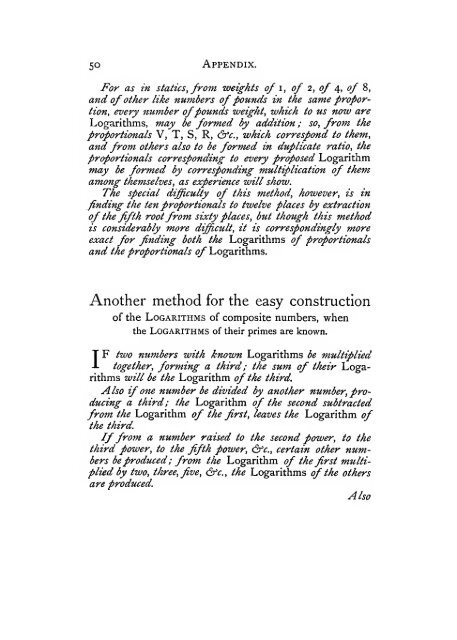
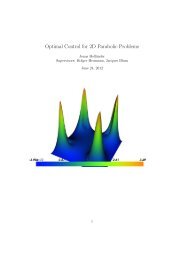
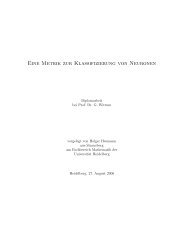
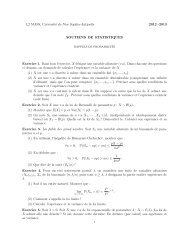
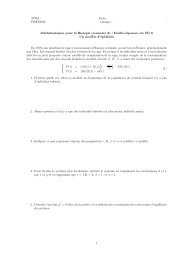


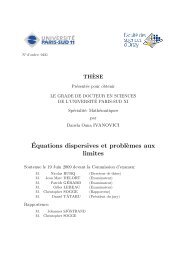
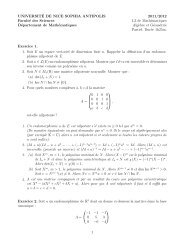
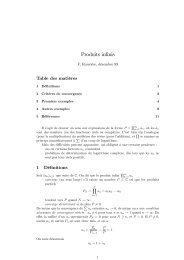
!['eries enti\`eres (+ [D78 Th d'Abel angulaire])](https://img.yumpu.com/14067031/1/184x260/eries-entieres-d78-th-dabel-angulaire.jpg?quality=85)

